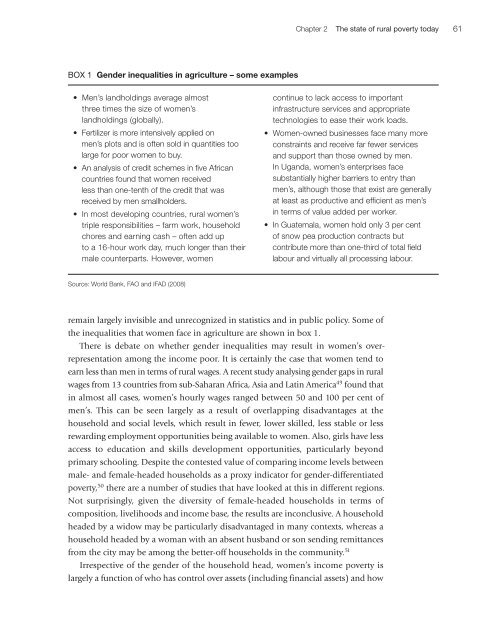English - IFAD
English - IFAD
English - IFAD
You also want an ePaper? Increase the reach of your titles
YUMPU automatically turns print PDFs into web optimized ePapers that Google loves.
Chapter 2 The state of rural poverty today 61<br />
BOX 1 Gender inequalities in agriculture – some examples<br />
• Men’s landholdings average almost<br />
three times the size of women’s<br />
landholdings (globally).<br />
• Fertilizer is more intensively applied on<br />
men’s plots and is often sold in quantities too<br />
large for poor women to buy.<br />
• An analysis of credit schemes in five African<br />
countries found that women received<br />
less than one-tenth of the credit that was<br />
received by men smallholders.<br />
• In most developing countries, rural women’s<br />
triple responsibilities – farm work, household<br />
chores and earning cash – often add up<br />
to a 16-hour work day, much longer than their<br />
male counterparts. However, women<br />
continue to lack access to important<br />
infrastructure services and appropriate<br />
technologies to ease their work loads.<br />
• Women-owned businesses face many more<br />
constraints and receive far fewer services<br />
and support than those owned by men.<br />
In Uganda, women’s enterprises face<br />
substantially higher barriers to entry than<br />
men’s, although those that exist are generally<br />
at least as productive and efficient as men’s<br />
in terms of value added per worker.<br />
• In Guatemala, women hold only 3 per cent<br />
of snow pea production contracts but<br />
contribute more than one-third of total field<br />
labour and virtually all processing labour.<br />
Source: World Bank, FAO and <strong>IFAD</strong> (2008)<br />
remain largely invisible and unrecognized in statistics and in public policy. Some of<br />
the inequalities that women face in agriculture are shown in box 1.<br />
There is debate on whether gender inequalities may result in women’s overrepresentation<br />
among the income poor. It is certainly the case that women tend to<br />
earn less than men in terms of rural wages. A recent study analysing gender gaps in rural<br />
wages from 13 countries from sub-Saharan Africa, Asia and Latin America 49 found that<br />
in almost all cases, women’s hourly wages ranged between 50 and 100 per cent of<br />
men’s. This can be seen largely as a result of overlapping disadvantages at the<br />
household and social levels, which result in fewer, lower skilled, less stable or less<br />
rewarding employment opportunities being available to women. Also, girls have less<br />
access to education and skills development opportunities, particularly beyond<br />
primary schooling. Despite the contested value of comparing income levels between<br />
male- and female-headed households as a proxy indicator for gender-differentiated<br />
poverty, 50 there are a number of studies that have looked at this in different regions.<br />
Not surprisingly, given the diversity of female-headed households in terms of<br />
composition, livelihoods and income base, the results are inconclusive. A household<br />
headed by a widow may be particularly disadvantaged in many contexts, whereas a<br />
household headed by a woman with an absent husband or son sending remittances<br />
from the city may be among the better-off households in the community. 51<br />
Irrespective of the gender of the household head, women’s income poverty is<br />
largely a function of who has control over assets (including financial assets) and how

















